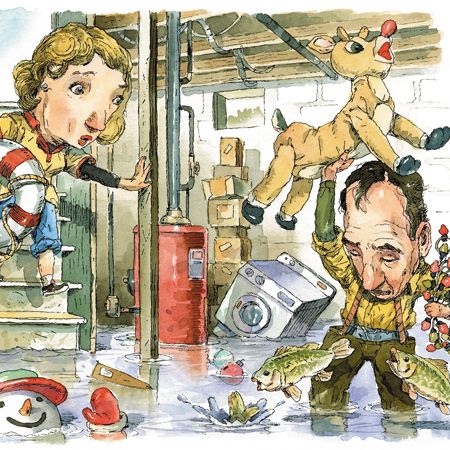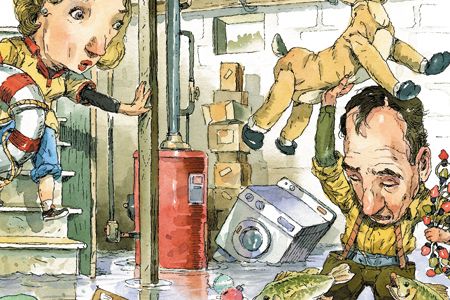
If you think a flooded basement is trouble, just wait till the water’s gone—getting rid of the mucked-up ruins and preventing mold growth are no simple tasks. One man learned this the hard way when a river near his home breached its banks. Luckily, his cleanup contractor knew all the right fixes.
The Client: Gary Fink, a deputy sheriff, who lives with his 3-year-old daughter in a two-bedroom ranch house in Findlay, Ohio.
The Crisis: Tsunami conditions in his house. Fink awoke at 5 a.m. one morning to crackling thunder and torrents of water from the overflowing Blanchard River pouring into his basement. Fink, who lives just two-tenths of a mile from the river, was somewhat prepared—he revved up two submersible water pumps and feverishly kept the flood at bay for a day. “The moment of no return came the next morning, when the pumps stopped running for a moment,” he says. “Instantly, water filled the basement faster than I could keep up.” Just before the water reached the waist-high electrical outlets, Fink decided to evacuate. He shut off the electricity, hauled out some photos and memorabilia, and left with his daughter in tow, returning periodically over the next couple of days as the floodwaters receded to rescue more of his possessions.
The Pro Steps In:
Fink called Dan DiPrima, a local technician for Flood Control Inc. When DiPrima saw the basement, he had one word: “Eeew.” There was murky standing water, plus lots of mud and muck from the river. “We wanted to get rid of the stuff as quickly as possible, because mold spores appear in 24 to 48 hours after a flood,” he says. “Then we’d sanitize.”
For 6 hours, DiPrima used truck-mounted pumps to shunt water through hoses into the street. Seven men shoveled out the sludge, kicked out the lightweight wooden partition walls in the basement, and carried out the losses: a washing machine, dryer, freezer, furnace, and electrical box, along with furniture and memorabilia. “Unfortunately, when floods come from water that’s been outside, the water is contaminated and it’s hard to save any walls, carpets, or contents,” says DiPrima.
Job done? Only if Fink wanted a house full of bacteria and mold. DiPrima rolled in a fog machine that spewed an antifungal, antibacterial mist into the basement, where it entered the wall cavities so the entire house got treated. Then he hooked up a truck-mounted industrial power sanitizer to clean the basement. “One hose sprays hot water at up to 200 degrees, and another hose extracts the water we’re spraying so you don’t make another flood.” Fink and his daughter stayed elsewhere while DiPrima and his crew worked.
With the basement now drenched but clean, DiPrima set up two industrial dehumidifiers and seven commercial oscillating fans, some of them upstairs, and left for a few days. When he returned, the basement was barren and dry. DiPrima included one more round of fogging for good measure.
The Aftermath:
DiPrima was the best part of Fink’s ordeal. “Dan came within 45 minutes of my call and cleaned up what had been a disaster area,” says Fink. DiPrima suggested the next moves, too: hiring an electrician, a furnace installer, and, most important, a duct cleaner. Mold spores can still live in ducts even if fogging treatments are successful, DiPrima explains.
Fortunately, Fink had flood and homeowner’s insurance that covered the structure and contents of his house; he received $15,000 toward the cost of repairs. When we spoke to him a few months after the flood, he was replacing his basement windows and fixing the back entryway by himself, because his insurance didn’t include labor costs.
The Bill
Flood Cleanup
Floor and wall sanitation (at $1.25 per square foot): $1,920
Trash removal: $500
Dehumidifiers and fans : $1,230
Fogger treatments: $950
Total: $4,600
Follow-up Work
Duct cleaning: $225
Additional cleanup (dehumidifier, wet vacuum): $275
Equipment refurbishment and replacement: $10,865
Total: $11,365
Grand total: $15,965

